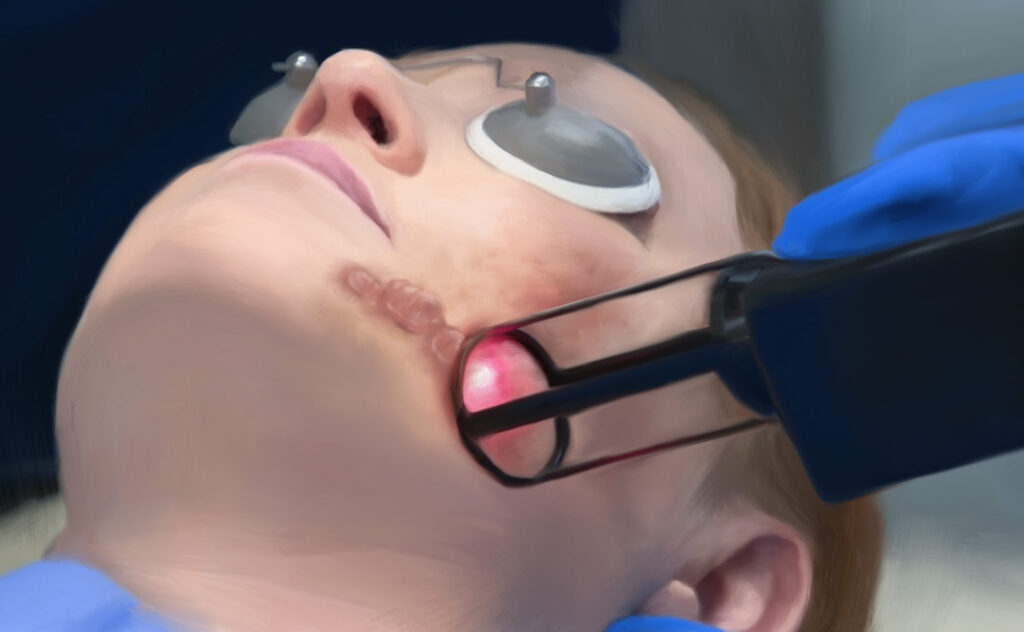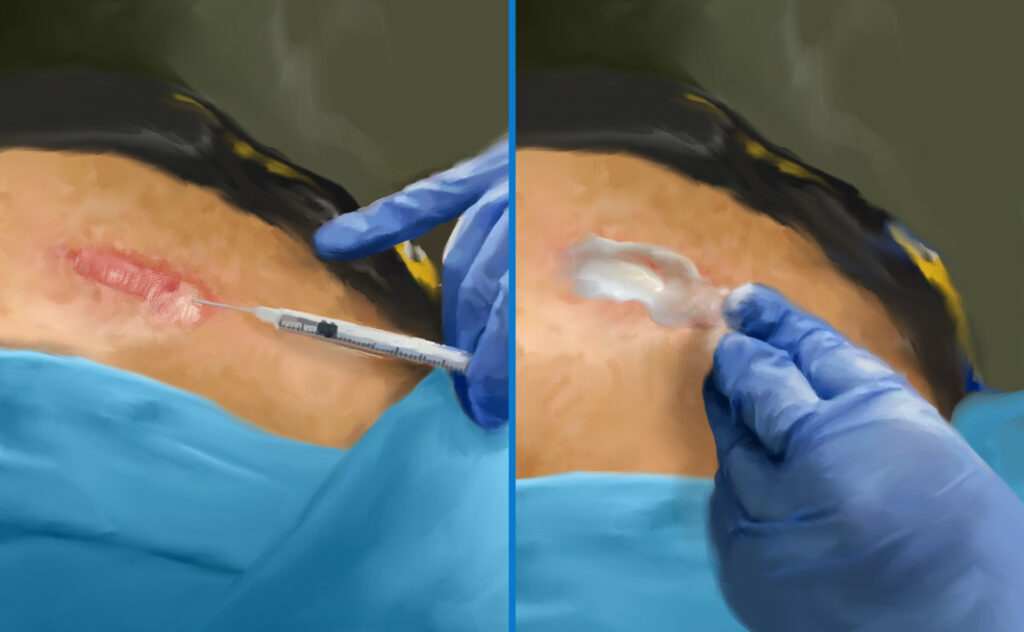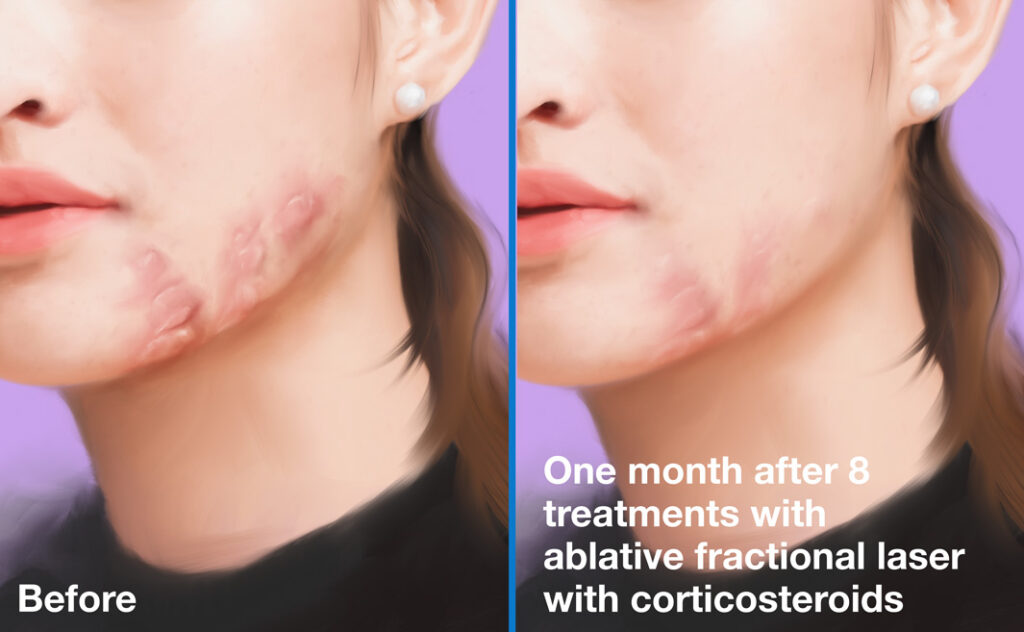Raised (hypertrophic) and keloid scars are raised scars containing excessive collagen, or in other words, scars caused by an overgrowth of collagen.
First, an ablative fractional laser is used to shine an intense beam of light onto the skin in a grid-like pattern so that areas of skin in between the pinpoints are left untouched.1,2 Ablative laser treatment degrades excess collagen in the scar tissue and reduces the appearance of raised scars.
Ablative (skin-removing) lasers: “Ablative” means “removing,” in this case, removing the skin. Ablative lasers work by quickly heating up water molecules in the epidermis (the upper layer of the skin), which essentially “vaporizes” this skin layer. Because ablative lasers completely remove the epidermis and trigger it to regrow, they can achieve good results, but also come with a long recovery time and a relatively high risk of side effects.3
Fractional lasers, also known as fractionated lasers: These newer lasers deliver many small pinpoints of laser light in a grid-like pattern so that areas of skin in between the pinpoints are left untouched. Because only a small portion of the skin is damaged, healing time is shorter than with non-fractional lasers which strip the epidermis from the entire section of the skin.4-6
There are 2 main subtypes of ablative fractional lasers, each named after the material used inside the laser device, and your doctor can discuss with you which is better for your particular raised scar(s). Lasers can be created using glass, crystals, or gasses, and the specific material determines the color of the laser light.2
The materials in lasers used for ablative fractional skin resurfacing include:
- Er:YAG (erbium-doped yttrium-aluminum-garnet) laser
- CO2 (carbon dioxide) laser
Next comes corticosteroid treatment, which involves injecting drugs called corticosteroids directly into the scar (intralesionally) or applying them topically on the scar surface.7,8
Corticosteroids are synthetic (made in a laboratory) drugs that may help further reduce scar size by:
- Stimulating collagen breakdown
- Decreasing collagen production
- Decreasing fibroblasts (cells that produce collagen)
- Reducing inflammation (which is what led to scar formation in the first place)
Adding topical corticosteroids to the ablative fractional laser treatment also reduces the risk of skin lightening (hypopigmentation) or darkening (hyperpigmentation) associated with ablative fractional laser.9
Summary of ablative fractional lasers with corticosteroids for raised scars:
- How it works: First, an ablative fractional laser completely removes (ablates) the epidermis of the raised scar in a dot-matrix pattern, leaving some of the skin intact. Next, corticosteroids are injected or applied topically to promote the degradation of collagen, decrease the production of collagen, the proliferation of cells that produce collagen and reduce inflammation.
- # of treatments: 3-5 treatments at intervals of 4 weeks1,2
- Advantages: Better results with shorter recovery time compared to ablative non-fractional lasers2
- Disadvantages: Scar regrowth (relatively rare when the procedure is performed correctly), high risk of side effects, expensive, requires multiple sessions2
As with all scar revision treatments, the combination of ablative fractional lasers with corticosteroids is sometimes combined with other scar revision procedures to attain desired results.
The combination of ablative fractional lasers and corticosteroids cannot be performed when there is an active skin infection or a skin condition such as a bacterial infection, eczema, or psoriasis. Ensure your skin is clear before seeking ablative fractional lasers with corticosteroid treatment.1
Doctors do not recommend undergoing any laser scar treatment, including ablative fractional lasers with corticosteroids for 6 months after taking oral isotretinoin (Accutane®), because, during this time, the skin may respond unpredictably to laser treatment.1
Before agreeing to undergo ablative fractional laser with corticosteroid treatment, discuss your treatment options, expected outcomes, and treatment prices with multiple doctors.
Procedure details:

Before booking your treatment, your doctor should first schedule a session to discuss the procedure, expected results, and possible complications with you and to answer your questions.
If you are planning to undergo treatment with an ablative fractional laser with corticosteroids, your doctor may prescribe antiviral medications for you to take before the procedure to prevent a viral skin infection from developing after treatment.3
Ablative fractional laser with corticosteroid treatment is usually performed in an outpatient setting.
During the treatment, the doctor will give you protective eyewear to prevent the laser from damaging your eyes.
The doctor will first perform an ablative fractional laser procedure. No matter which type of laser your doctor uses, he will have to fine-tune the laser settings in order to get the best results while minimizing recovery time and side effects. Once the settings are dialed in, he will make several passes over your scar with the laser, which produces mild pain.3
About 5 to 10 minutes later, the doctor will either inject a corticosteroid (usually triamcinolone, although other corticosteroids may also be used) directly into the raised scar or will instruct you to apply a corticosteroid topically about 2 to 3 hours after the procedure.
Intralesional injection of corticosteroid: The corticosteroid is injected into the middle of the dermis, the deeper skin layer underneath the raised scar.7 Injecting the drug into the middle of the dermis helps it work and reduces the chances of skin thinning (atrophy), which can be a side effect of intralesional corticosteroids.8
- Corticosteroids dose: Typical doses of corticosteroids are 10-20 mg/ml, but can be as high as 40 mg/ml for very thick scars. The doctor must weigh the efficacy of the treatment, which tends to increase with a higher dose, against the risk of side effects, which also increases with a higher dose.7
Topical application of corticosteroids: Corticosteroids can also be applied topically to the scar surface 2 to 3 hours after ablative fractional laser treatment in the form of cream or suspension (a liquid form of corticosteroid). Usually, the doctor will give you a corticosteroid cream or suspension and instruct you regarding how and when to use it. Triamcinolone is a commonly used corticosteroid for topical application, however, betamethasone is another common corticosteroid when topical application is used. Both are usually given in a dose of 10-20 mg/ml.

Anesthesia:
Ablative fractional laser treatment can be uncomfortable and can require anesthesia. Before laser treatment, your doctor may choose to numb the skin with:
- Topical anesthesia: A dressing containing a numbing cream is applied to the skin 30 to 60 minutes before the procedure9
Intralesional injection of corticosteroids can also be painful. In some cases, even if no anesthetic is applied before the ablative fractional laser, an anesthetic may be mixed with the corticosteroid in the same syringe before being injected.
Before-and-after:

Before and one month after 8 treatment sessions with ablative fractional laser and topical corticosteroid cream.
References
- Omi T, Numano K. The Role of the CO2 Laser and Fractional CO2 Laser in Dermatology. Laser Ther. 23(1), 49-60 (2014).
- Buhalog B, Moustafa F, Arkin L, Lee K, Siwy K, Donelan M, Hultman CS, Shumaker PR. Ablative fractional laser treatment of hypertrophic burn and traumatic scars: a systematic review of the literature. Arch Dermatol Res. 313(5), 301-17 (2021).
- Choi JE, Oh GN, Kim JY, Seo SH, Ahn HH, Kye YC. Ablative fractional laser treatment for hypertrophic scars: comparison between Er:YAG and CO2 fractional lasers. J Dermatolog Treat. 25(4), 299-03 (2014).
- Oosterhoff TCH, Beekman VK, van der List JP, Niessen FB. Laser treatment of specific scar characteristics in hypertrophic scars and keloid: A systematic review. J Plast Reconstr Aesthet Surg. 74(1), 48-64 (2021).
- Choi KJ, Williams EA, Pham CH, Collier ZJ, Dang J, Yenikomshian HA, Gillenwater TJ. Fractional CO2 laser treatment for burn scar improvement: A systematic review and meta-analysis. Burns. 47(2), 259-69 (2021).
- Manuskiatti W, Kaewkes A, Yan C, Ng JN, Glahn JZ, Wanitphakdeedecha R. Hypertrophic Scar Outcomes in Fractional Laser Monotherapy Versus Fractional Laser-Assisted Topical Corticosteroid Delivery: A Randomized Clinical Trial. Acta Derm Venereol. 101(3), adv00416 (2021).
- Zhou J, Hao F, Huang L, Fu Q, Yuan L, Luo G, Tan J. Treatment of hypertrophic scars with ablative fractional carbon dioxide laser assisted with different topical triamcinolone delivery ways. Heliyon. 9(12), e22818 (2023).
- Alexander S, Girisha BS, Sripathi H, Noronha TM, Alva AC. Efficacy of fractional CO2 laser with intralesional steroid compared with intralesional steroid alone in the treatment of keloids and hypertrophic scars. J Cosmet Dermatol. 18(6), 1648-1656 (2019).
- Cheyasak N, Manuskiatti W, Maneeprasopchoke P, Wanitphakdeedecha R. Topical corticosteroids minimise the risk of postinflammatory hyper-pigmentation after ablative fractional CO2 laser resurfacing in Asians. Acta Derm Venereol. 95(2), 201-5 (2015).
- Abd El-Dayem DH, Nada HA, Hanafy NS, Elsaie ML. Laser-assisted topical steroid application versus steroid injection for treating keloids: A split side study. J Cosmet Dermatol. 20(1), 138-42 (2021).
 Acne.org Products
Acne.org Products